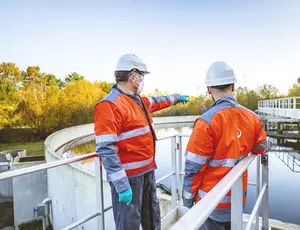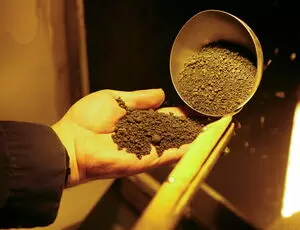An anaerobic treatment technology for industrial wastewater that is high in fats and suspended solids.
Overview
Industrial companies are continually improving waste disposal and energy efficiency at their facilities to meet tightening environmental targets and net zero carbon goals. To help environmental management in sectors like food and beverage, oil and gas, and biofuels, at Veolia Water Technologies we are innovating to support these ambitions.
Sparthane is a modular AD technology that can convert sludge from industrial wastewater into a robust energy resource. It is designed with a high tolerance for FOG and TSS.
Deployment of Sparthane means the biomass feedstock does not require any pretreatment, and once fed into the anaerobic reactor, is efficiently converted into valuable biogas.
First, waste streams are collected in the mixed buffer tank, where an acidification process takes place. Next, gases are removed from the biomass in the batch degassing tank (BDT).
The final liquid effluent is separated out and clarified in the semi-continuous settler (SCS). Clarification removes suspended solids through gravity settling, providing a clear liquid effluent that can be safely discharged.
This sludge treatment process leaves a more concentrated biomass that can be returned to the anaerobic reactor to start the Sparthane sequence again. This unique processing sequence ensures the substrate is completely degraded, enabling the maximum possible biogas production.

Features and benefits
Treatment capabilities:
- Effective on high levels of FOGs, up to 4 grams per liter (g/liter).
- Meets a wide range of chemical oxygen demand (COD) levels from 5 to 50g/liter.
- Meets high concentrations of TSS, up to 20g/liter.
Biogas production and performance:
- Maximizes biogas production capability — for typical food industry effluents, this results in 25 to 50% more
- biogas than installations that include primary treatment
- High treatment performance with no primary waste generation.
- High operational flexibility with wide tolerance for feed fluctuations.
- Final effluent clarified and ready for discharge.
Cost and efficiency:
- Lowest operational costs for anaerobic treatment.
- No need for pretreatment chemicals, including coagulants and flocculants.
- No dissolved air floatation (DAF) system required.
Design and engineering:
- Modular pre-engineered units that meet high standards in terms of safety and quality.
- Automated process control secures performance remotely by a self-regulating operations regime with optimized set-points in the wastewater characteristics.
Service and support:
- Systems serviced by our local service teams.
Features and benefits
Treatment capabilities:
- Effective on high levels of FOGs, up to 4 grams per liter (g/liter).
- Meets a wide range of chemical oxygen demand (COD) levels from 5 to 50g/liter.
- Meets high concentrations of TSS, up to 20g/liter.
Biogas production and performance:
- Maximizes biogas production capability — for typical food industry effluents, this results in 25 to 50% more biogas than installations that include primary treatment.
- High treatment performance with no primary waste generation.
- High operational flexibility with wide tolerance for feed fluctuations.
- Final effluent clarified and ready for discharge.
Cost and efficiency:
- Lowest operational costs for anaerobic treatment.
- No need for pretreatment chemicals, including coagulants and flocculants.
- No dissolved air floatation (DAF) system required.
Design and engineering:
- Modular pre-engineered units that meet high standards in terms of safety and quality.
- Automated process control secures performance remotely by a self-regulating operations regime with optimized set-points in the wastewater characteristics.
Service and support:
- Systems serviced by our local service teams.
Applications
Services
Our comprehensive service offering encompasses the refurbishment and reengineering of installations, ensuring that your systems and infrastructure are optimized for peak performance. We also specialize in planned service and preventive maintenance, proactively addressing potential issues to minimize downtime and costly repairs. Additionally, our expertise extends to conducting global water audits, providing a thorough assessment of water-related processes to enhance efficiency and sustainability. With our commitment to excellence, we empower your organization to achieve superior operational results while conserving valuable resources.
Product range and Resources
Sparthane Advanced®
Sparthane Advanced is a modular anaerobic digestion technology that can convert sludge from industrial wastewater into a robust energy resource without pretreatment. It is designed with a high tolerance for fats, oils and grease, and high levels of total suspended solids.
Contact
Sparthane allows the biomass to work its hardest for the client by maximizing its potential for biogas production. Sparthane can treat very difficult waste streams, for example coming from ice cream production, , it also means more natural gas to add to the energy mix, which will help reduce reliance on fossil fuels.

Christian Kuijlaars
Global Sales Manager
Contact Christian through his Linkedin account
FAQ about Sparthane
How can I treat wastewater with high levels of total suspended solids?
Normal clarification in the wastewater treatment process is made up of three steps: coagulation, flocculation, and sedimentation. Together, these processes can remove suspended solids and particulate matter, resulting in water with reduced TSS and turbidity.
What are the benefits of industrial effluent treatment?
Effective industrial effluent treatment can produce both clean and reusable water, as well as reducing overall waste production. Key benefits are:
- Wastewater treatment reduces the amount of waste and harmful contaminants released into the environment.
- Water loss due to water pollution is reduced or eradicated.
- Recovering reusable biogas as well as natural fertilizer to be used in agriculture.
- Simplified waste disposal significantly reduces costs.
- Regional wastewater treatment and industrial effluent standards can be met and maintained, and regulatory compliance can be continuously monitored.
How has anaerobic digestion treatment technology advanced?
- Anaerobic digestion treatment technology has advanced a lot in recent years, driven by a growing emphasis on sustainable waste management, renewable energy production, and environmental conservation. Here are some key advancements:
Improved feedstock flexibility
Traditional anaerobic digestion mostly used organic waste from sources like wastewater treatment plants and agricultural residues. Advances have expanded the range of feedstocks to include food waste, energy crops, and various organic materials.
Pre-treatment technologies
Pre-treatment methods, such as mechanical and thermal pre-processing, have been developed to enhance the digestion process. These methods help break down complex organic compounds, making them more accessible to microorganisms, and therefore improving biogas production.
Enhanced microbial management
Research into microbial communities within anaerobic digesters has led to better understanding and control of the digestion process to improve performance.
Nutrient recovery
Nutrient recovery technologies have been integrated into anaerobic digestion systems. Phosphorus and nitrogen can now be recovered during the process, reducing environmental pollution and providing valuable resources for agriculture.
These are some of the advancements that have made anaerobic digestion an increasingly attractive option for sustainable waste management, renewable energy production, and resource recovery. Therefore contributing to a more circular and environmentally friendly approach to waste and wastewater treatment.








